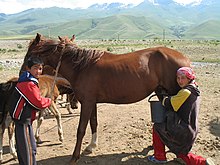
The Kinsky Horse is a Czech breed of warmblood sport horse. It was bred by the Kinsky family in the Kingdom of Bohemia, and is now one of four warmblood sport horse breeds reared in the Czech Republic, the others being the Czech Warmblood, the Slovakian Warmblood and the Moravian Warmblood. It was for many years absorbed into the Czech Warmblood; a separate stud-book was established in 2005. It is characterised by an unusual golden-yellow coat, though other colours are also seen.

The Irish Sport Horse, or Irish Hunter, is an Irish breed of warmblood sporting horse, used mostly for dressage, eventing and show-jumping. It was bred from 1923 by cross-breeding of Irish Draught and Thoroughbred stock. There was some limited intromission of Hanoverian, Selle Français and Trakehner blood in the 1990s. It is a recognised true breed – foals may only be registered in the main section of the stud-book if both parents are registered in that section.
The Priob or Ob is an endangered Russian breed of small horse from the Khanty-Mansi Autonomous Okrug, in Tyumen Oblast in the Russian Federation. It is distributed in the area of the Irtysh and lower Ob Rivers in western Siberia, and is a traditional breed of the indigenous people of that area, who used it for agriculture, for draft work, for forestry, and as a pack-horse.

The Ukrainian Riding Horse or Ukrainian Saddle Horse is a modern Ukrainian breed of warmblood sport horse. Breeding began in the years after the Second World War at the stud farm of Dnipropetrovsk in central Ukraine – at that time in the USSR – and later expanded to three other state stud farms. It derives from cross-breeding of Hanoverian, Thoroughbred and Trakehner stallions with local mares or with Hungarian Furioso, Gidran Arab or Nonius mares. It incorporates the last bloodlines of the extinct Orlov-Rostopchin or Russian Saddle Horse. It was bred to compete in show jumping, three-day eventing and dressage, but is also suitable as a general riding horse.
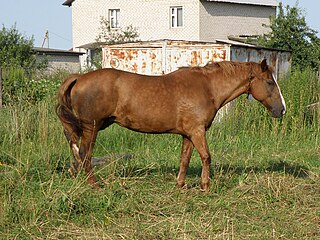
The Belarus Harness Horse, Belarusian: Беларускі запражны конь, romanized: Bielaruski zapražny koń, is a Belarusian breed of draught horse. It was bred for use in agriculture, and is also used to produce mare's milk and horsemeat.
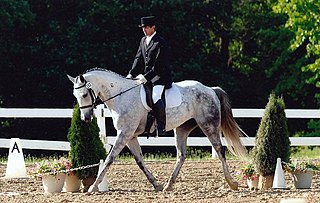
The Hungarian Sport Horse, Hungarian: 'Magyar sportló', is a modern Hungarian breed of sporting horse. Like the Furioso-North Star, the Gidran, and the Nonius, it was developed at the Hungarian State Stud Mezőhegyes, in Békés county in the Southern Great Plain region of south-eastern Hungary. At the end of 2012, the total number for the breed was reported to be 1091. The breeders' association is the Magyar Sportlótenyésztők Országos Egyesülete, or Association of Hungarian Sporthorse Breeders.

The Soviet Heavy Draft is a Russian breed of heavy draft horse. It derives from the Belgian Brabant heavy draft breed. It was developed in the former Soviet Union for agricultural draft work, and was recognized as a breed in 1952. It is one of several heavy draft breeds developed in the Soviet Union in the twentieth century, others being the Russian Heavy Draft – which derived mainly from the Ardennais – and the Vladimir Heavy Draft, which was derived principally from the Clydesdale.

The Latvian Horse is a purpose-bred warmblood horse breed from Latvia. Breeding began in Latvia in the early twentieth century, and a herd book was established in 1927. The breed was officially recognised in 1952. There are two types, sometimes called the Latvian Harness Horse and the Latvian Riding Horse. The harness type was predominant until about 1960, when demand for sport horses increased and more of the saddle type were bred.

The North Swedish Horse is a Swedish breed of small heavy horse. It is closely related to the similar Dølehest breed of Norway. It was traditionally used for forestry and agricultural work. Lighter lines are bred for harness racing, and are registered in the stud-book of the Svensk Kallblodstravare.
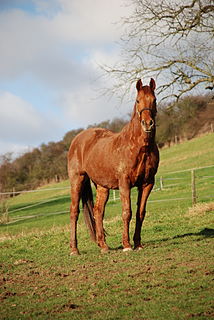
The Rhenish Warmblood, German: Rheinisches Warmblut or Rheinisches Reitpferd, is a German warmblood breed of sport horse. It was registered with the Rheinisches Pferdestammbuch until 2014, when the Hannoveraner Verband took over management of the stud-book. It is traditionally bred around Warendorf State Stud, which it shares with the Westphalian, and is bred to the same standard as the Westphalian and other German warmbloods, such as the Bavarian Warmblood, Mecklenburger, Brandenburger, and Württemberger.

The French Trotter is a French breed of trotting horse bred for racing both ridden and in harness. It was bred specifically for racing in the nineteenth century, principally in Normandy in north-western France.
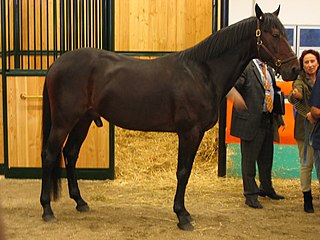
The Italian Trotter, Italian: Trottatore Italiano, is the Italian breed of trotting horse. It has been selectively bred exclusively for its racing ability. Varenne, one of most successful trotters in the history of the sport, was an Italian Trotter.

The Romanian Sport Horse or Romanian Saddle Horse, Romanian: Cal de sport romanesc, is a Romanian breed of light riding horse. It was bred from 1962 from a variety of other breeds including Arab, Furioso-North Star, Gidran, Romanian Trotter and Thoroughbred. It is used as a carriage horse, for riding, for showing and as a sport horse. It is well-suited to show-jumping.

The Boerperd is a modern breed of horse from South Africa. It is a re-creation of the traditional Cape Horse or old-type Boer Horse, which is now extinct.
The Shan Horse or Shan Myinn is a breed of small mountain horse or pony from the Shan Highland, in Shan State in eastern Myanmar (Burma). It was traditionally bred by the Shan people of that area. It is one of two horse breeds in Myanmar, the other being the Burmese Horse. It is similar to the Indian Manipuri, Spiti and Bhutia breeds of small horse or pony.
The Burmese Horse or Bama Myinn is a breed of horse from Myanmar (Burma). It is one of two horse breeds in Myanmar, the other being the Shan Horse.
The Belgian Trotter, Dutch: Belgische Draver, French: Trotteur Belge, is a Belgian breed of trotting horse. It is used mostly for racing in harness to a sulky, but may also run in saddled trotting races.

The Belgian Sport Horse, Dutch: Belgisch Sportpaard, French: Cheval de Sport Belge, is a Belgian breed of warmblood sport horse. It is one of three Belgian warmblood breeds or stud-books, the others being the Belgian Warmblood and the Zangersheide. It is bred for dressage, for show-jumping and for three-day eventing.
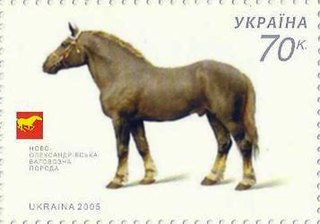
The Novoolexandrian Draught is a Ukrainian breed of draught horse. It is named for the state stud farm of Novo-Oleksandrivka in Bilovodsk Raion of Luhansk Oblast in the easternmost part of Ukraine, where it was bred. It shares its early history with the Russian Heavy Draught bred in Imperial Russia in the second half of the nineteenth century, and until after the Russian Revolution known as the Russian Ardennes; later development took place in Ukraine, where it received official recognition in 1999. It was bred for draught work, but it is also reared for meat and particularly for mare's milk, of which it is a high-yielding producer.

The Strelets Arab or Strelets Horse is an extinct Ukrainian breed of light cavalry horse. It was bred in the nineteenth century at the Striletsky State Stud in Luhansk Oblast of Ukraine, from Arab and a variety of other stock. As with other Russian horse populations, its numbers were gravely reduced by the events of the Russian Revolution and the Russian Civil War, and it came close to disappearing. Two stallions and a few mares survived, which was judged to be too small a number to allow the breed to be recovered. Instead, they were taken to the Tersk Stud in the North Caucasus and used as the foundation stock in the development of the new Tersk breed of riding horse. The Strelets also contributed to the development of the Don and Kustanai breeds.
